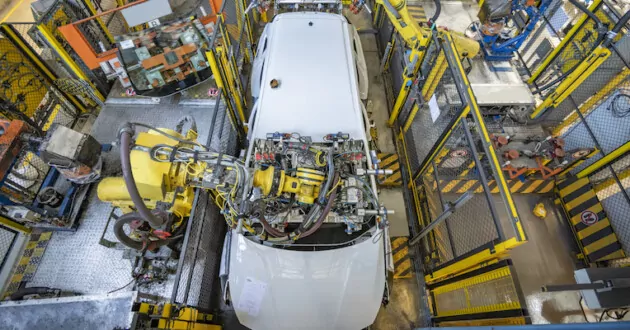
The oil and gas industry remains an integral part of the energy landscape, but it faces a number of modern challenges, including volatile market conditions, expanding environmental regulations and the growing need for operational efficiency.
To navigate these challenges, industry players are turning to enterprise asset management (EAM) solutions. EAM is an invaluable tool that allows oil and gas companies to manage physical assets and infrastructure throughout their lifecycles—from design and procurement to maintenance and disposal.
As of 2022, the EAM market was valued at nearly $6 billion, with a compound annual growth rate of 16.9% through 2030. Here, we’ll discuss potential applications for EAM software in oil and gas and talk about the trends pushing the industry forward.
Understanding enterprise asset management
At its core, enterprise asset management (EAM) is a system designed to help organizations manage physical assets (e.g., equipment, machinery and infrastructure). It offers a holistic view, providing critical data about asset condition, location and efficiency.
EAM systems can include functions like maintenance management, asset lifecycle management, inventory management and work order management, among others. More recently, these systems have integrated advanced technologies like Internet of Things (IoT), artificial intelligence (AI) and machine learning (ML) to enable predictive analytics and real-time monitoring.
How EAM can help oil and gas companies
Enterprise asset management (EAM) can help companies more easily manage a complex array of assets, from drilling rigs and pipelines to refineries and storage facilities. The following are some of the most impactful ways oil and gas is embracing EAM as an asset management strategy:
- Asset lifecycle management: Oil and gas assets are intricate, costly and have lengthy lifecycles. EAM systems provide a centralized repository of all asset-related information, allowing teams to track the performance of each asset and make informed decisions about maintenance, upgrades and replacements.
- Predictive and preventive maintenance: The advent of IoT and AI technologies has transformed EAM systems into predictive maintenance tools. Sensors attached to assets can now gather asset data in real-time, and AI algorithms can analyze the data to predict potential equipment failures. EAM also plays an important role in preventive maintenance, which involves routine inspections and servicing to prevent breakdowns. Using EAM data to implement predictive and preventive maintenance programs helps oil and gas companies take a more proactive approach to asset maintenance, reducing unexpected downtime and minimizing costs associated with emergency repairs.
- Regulatory compliance: The oil and gas industry is subject to stringent regulatory requirements related to safety, environmental impact and asset integrity. EAM can help companies stay compliant by providing up-to-date documentation, tracking necessary inspections, ensuring that all equipment meets the required standards, and providing alerts for upcoming compliance-related activities. This not only helps businesses avoid regulatory penalties, but it also creates safer operations and improves public perception.
- Cost control and budgeting: EAM systems provide valuable insights into asset performance as it relates to maintenance costs. By analyzing asset data, companies can identify inefficiencies, uncover cost-saving opportunities and make more accurate budget forecasts.
- Inventory management: Managing an inventory of spare parts and materials is a significant challenge for oil and gas companies. EAM systems can provide around-the-clock visibility into inventory levels, allowing businesses to track part usage, automate reordering processes, prevent stockouts and overstocking, reduce carrying costs and ultimately ensure that parts are available when teams need them.
- Risk management: Because EAM offers a comprehensive view of all critical assets, it can be an invaluable tool for identifying potential risks, empowering companies to take preemptive steps to avoid accidents and operational disruptions.
How EAM is driving the future of oil and gas
As enterprise asset management (EAM) technology continues to evolve, new trends emerge, promising to transform the way oil and gas companies approach asset performance management. But which innovations are showing the most potential? Let’s discuss (in no particular order).
Trend #1: Integrating EAM and digital twins
Digital twins—virtual replicas of physical assets, processes and/or systems—have been gaining considerable traction in the oil and gas sector. When integrated with EAM, digital twins offer the ability to simulate various operational scenarios and anticipate asset disruptions. Access to asset/system simulations can enable more proactive maintenance planning, improved decision-making and better risk management. It can also significantly increase uptime and lifespan.
Trend #2: Using blockchain in EAM systems
Blockchain technology has the potential to bring transparency, security and traceability to EAM. Blockchain provides a secure, decentralized record of all asset-related transactions, enhancing auditability and reducing the risk of fraud and error. While still in its early stages, the use of blockchain in EAM is a trend worth watching.
Trend #3: EAM powered by AI and machine learning
AI and ML are super-charging EAM systems, taking the predictive capability of EAM to the next level. By collecting and analyzing vast amounts of data from asset sensors, these technologies can predict equipment failures with greater accuracy and improve overall asset reliability.
Trend #4: Combining the features of augmented reality with EAM capabilities
By integrating augmented reality (AR) with EAM, oil and gas companies can enhance the efficiency and effectiveness of their maintenance processes. AR technology overlays digital information onto the physical world, helping technicians visualize complex procedures and diagnose equipment issues. In the event of a breakdown, maintenance teams can use AR glasses to view real-time asset data, see step-by-step repair instructions and even get remote assistance from experts.
Trend #5: The rise of mobile EAM solutions
Mobile technology is making EAM more accessible than ever. Technicians can now access asset information, metrics, maintenance schedules and detailed work instructions from their mobile devices, regardless of their location. This not only improves productivity, but it also ensures that the most accurate and up-to-date information is always at the team’s fingertips.
Trend #6: Pushing sustainability with EAM solutions
Sustainability is a pressing concern for the oil and gas industry, and EAM systems are evolving to support these initiatives. Modern EAM systems can help companies monitor and reduce their environmental impact, track their carbon footprint and ensure compliance with environmental regulations. These new features empower businesses to address practices that harm the environment and still maximize profits.
Use IBM Maximo Application Suite to take your enterprise asset management (EAM) to the next level
The oil and gas industry stands to benefit significantly from EAM systems, which have the power to deliver valuable insights that can help oil and gas companies optimize operations, improve profitability and stay competitive in a challenging industry landscape. And by integrating EAM with other business systems—like enterprise resource planning (ERP) and customer relationship management (CRM)—businesses can take a more holistic approach to operations.
However, the successful implementation of EAM requires extensive personnel training, comprehensive change management initiatives and a strategic approach that aligns with the company’s business objectives. It also benefits from advanced asset management software, like IBM Maximo.
IBM Maximo Application Suite is an integrated asset management solution that helps oil and gas providers improve performance, streamline day-to-day operations and simplify digital transformation processes. Using an integrated AI-powered, cloud-based platform, Maximo offers CMMS, EAM and APM capabilities that produce advanced analytics and help utilities make smarter, more data-driven decisions.
But the future of EAM in the oil and gas industry is not just about adopting new technologies. It’s also about transforming business processes and culture.
With the right approach—and IBM Maximo—EAM can be a powerful tool for driving operational excellence and innovation in the oil and gas industry for decades to come.
To find out how, book a live demo with an IBM expert
More from IBM Maximo

10 ways the oil and gas industry can leverage digital twin technology
5 min read – The oil and gas industries have been the backbone of the global economy for decades. However, market volatility, environmental concerns and operational inefficiencies have also challenged these industries to adapt and innovate. The use of digital twins is one such innovation. In the era of digital transformation, digital twins are emerging as a potent solution to energy production challenges. Digital twin technology, an advancement stemming from the Industrial Internet of Things (IIoT), is reshaping the oil and gas landscape by…
5 min read

Optimizing energy production with the latest smart grid technologies
5 min read – New technologies are shaping the way we produce, distribute and consume energy. Smart grid technology—an integral part of energy’s digital transformation—promises to modernize the traditional electrical system with an infusion of digital intelligence that helps energy providers transition to clean energy and reduce carbon emissions. The U.S. alone has installed nearly 10,000 electricity generation units, connected by more than 300,000 miles of transmission lines and capable of generating over a million megawatts of energy. But the import of smart grid…
5 min read

Contingency plan examples: A step-by-step guide to help your business prepare for the unexpected
7 min read – Enterprises are often defined by how they deal with events that are out of their control. For example, how you react to a disruptive technology or cope with a sudden change in the markets can be the difference between success and failure. Contingency planning is the art of preparing for the unexpected. But where do you start and how do you separate the threats that could do real harm to your business from the ones that aren’t as critical? Here…
7 min read

OEE vs. TEEP: What’s the difference?
4 min read – Breakdowns, equipment failure, outages and other shop floor disruptions can result in big losses for an organization. Production managers are tasked with ensuring that factories and other production lines are getting the most value out of their equipment and systems. Overall equipment effectiveness (OEE) and total effective equipment performance (TEEP) are two related KPIs that are used in manufacturing and production environments to help prevent losses by measuring and improving the performance of equipment and production lines. What is overall…
4 min read
- SEO Powered Content & PR Distribution. Get Amplified Today.
- PlatoData.Network Vertical Generative Ai. Empower Yourself. Access Here.
- PlatoAiStream. Web3 Intelligence. Knowledge Amplified. Access Here.
- PlatoESG. Automotive / EVs, Carbon, CleanTech, Energy, Environment, Solar, Waste Management. Access Here.
- BlockOffsets. Modernizing Environmental Offset Ownership. Access Here.
- Source: https://www.ibm.com/blog/six-eam-trends-pushing-the-oil-and-gas-industries-forward/
- :has
- :is
- :not
- :where
- 000
- 10
- 11
- 12
- 16
- 2022
- 2023
- 2030
- 25
- 26
- 27
- 28
- 30
- 300
- 36
- 39
- 40
- 9
- a
- ability
- About
- access
- accessible
- accidents
- accuracy
- accurate
- activities
- adapt
- address
- Adopting
- advanced
- advancement
- advent
- Advertising
- AI
- AI-powered
- alerts
- algorithms
- Aligns
- All
- Allowing
- allows
- alone
- also
- always
- among
- amounts
- amp
- an
- analytics
- analyze
- analyzing
- and
- and infrastructure
- annual
- anticipate
- Application
- applications
- approach
- AR
- AR Glasses
- ARE
- Array
- Art
- article
- AS
- asian
- asset
- asset management
- Assets
- Assistance
- associated
- At
- augmented
- Augmented Reality
- augmented reality (ar)
- author
- automate
- available
- avoid
- back
- Backbone
- background
- BE
- because
- been
- benefit
- benefits
- Better
- between
- Big
- blockchain
- Blog
- book
- Breakdown
- bring
- budget
- business
- business processes
- businesses
- businessman
- but
- by
- CAN
- capabilities
- capability
- capable
- car
- carbon
- carbon emissions
- carbon footprint
- card
- Cards
- carrying
- CAT
- centralized
- challenge
- challenged
- challenges
- challenging
- change
- Chart
- check
- checking
- China
- cityscape
- class
- clean energy
- Collecting
- color
- combining
- come
- Companies
- Company’s
- competitive
- complex
- compliance
- compliant
- Compound
- comprehensive
- concept
- Concern
- Concerns
- condition
- conditions
- connected
- considerable
- consume
- Container
- continue
- continues
- control
- Core
- costly
- Costs
- could
- creates
- critical
- CRM
- CSS
- Culture
- custom
- customer
- customer relationship management
- data
- data-driven
- Date
- day-to-day
- deal
- decades
- decentralized
- Decision Making
- decisions
- Default
- defined
- definitions
- deliver
- Demo
- description
- Design
- designed
- detailed
- Devices
- difference
- digital
- Digital Transformation
- digital twin
- Digital twins
- discuss
- disruptions
- disruptive
- distribute
- do
- documentation
- downtime
- driving
- e
- each
- Early
- easily
- economy
- Effective
- effectiveness
- efficiency
- electricity
- embracing
- emerge
- emergency
- emerging
- Emissions
- empower
- empowering
- enable
- energy
- engineer
- enhance
- enhancing
- ensure
- ensures
- ensuring
- Enter
- Enterprise
- Environment
- environmental
- environmental concerns
- environments
- equipment
- Era
- ERP
- error
- Ether (ETH)
- Even
- Event
- events
- EVER
- evolve
- evolving
- Examining
- example
- examples
- Excellence
- Exit
- expanding
- experts
- extensive
- faces
- facilities
- factories
- factory
- Failure
- Features
- Find
- Floor
- follow
- following
- fonts
- Footprint
- For
- forecasts
- Forward
- fraud
- from
- functions
- future
- gaining
- GAS
- gather
- generating
- generation
- generator
- get
- getting
- glasses
- Global
- Global economy
- greater
- Grid
- Growing
- Growth
- guide
- harm
- Have
- height
- help
- helping
- helps
- here
- his
- holistic
- How
- However
- HTTPS
- IBM
- ICO
- ICON
- identify
- identifying
- image
- Impact
- impactful
- implement
- implementation
- import
- important
- improve
- improved
- improves
- improving
- in
- include
- Including
- Increase
- index
- industrial
- industries
- industry
- information
- informed
- Infrastructure
- infusion
- initiatives
- innovate
- Innovation
- innovations
- insights
- instructions
- integral
- integrated
- Integrating
- integrity
- Intelligence
- Internet
- internet of things
- into
- invaluable
- inventory
- iot
- issues
- IT
- ITS
- jpg
- July
- just
- landscape
- large
- latest
- Level
- levels
- Leverage
- lifecycle
- lifecycles
- lifespan
- like
- Line
- lines
- live
- location
- losses
- machine
- machinery
- maintenance
- make
- Making
- manage
- management
- Management Solution
- Managers
- managing
- manufacturing
- Market
- market conditions
- market volatility
- Markets
- materials
- max-width
- Maximize
- measuring
- Meets
- Metrics
- million
- min
- minimizing
- minutes
- ML
- Mobile
- mobile devices
- mobile phone
- Modern
- modernize
- Monitor
- monitoring
- more
- most
- Navigate
- Navigation
- nearly
- necessary
- Need
- New
- New Features
- New technologies
- next
- night
- no
- nothing
- now
- number
- objectives
- of
- offer
- Offers
- often
- Oil
- Oil and Gas
- on
- ONE
- ones
- only
- operational
- Operations
- opportunities
- Optimize
- optimized
- optimizing
- or
- order
- organization
- organizations
- Other
- Others
- out
- Outages
- over
- overall
- overstocking
- page
- part
- particular
- parts
- perception
- performance
- Personnel
- phone
- PHP
- physical
- pipe
- plan
- planning
- platform
- plato
- Plato Data Intelligence
- PlatoData
- players
- plays
- plugin
- policy
- position
- Post
- potential
- power
- powered
- powerful
- practices
- predict
- Predictive Analytics
- Prepare
- preparing
- pressing
- prevent
- Proactive
- procedures
- processes
- procurement
- produce
- Production
- productivity
- profitability
- profits
- promising
- provide
- providers
- provides
- providing
- public
- Pushing
- R
- Rate
- React
- Reading
- real
- real-time
- Reality
- recently
- record
- reduce
- reducing
- Regardless
- regulations
- regulatory
- related
- relationship
- remains
- remote
- remote assistance
- repair
- repository
- required
- Requirements
- requires
- resource
- responsive
- result
- right
- Rise
- Risk
- risk management
- risks
- robots
- Role
- s
- safer
- Safety
- scenarios
- Screen
- scripts
- sector
- secure
- security
- see
- sensors
- seo
- separate
- shaping
- Shop
- showing
- significant
- significantly
- simplify
- site
- SIX
- small
- smart
- smarter
- Software
- solution
- Solutions
- some
- Sponsored
- stages
- standards
- stands
- start
- stats
- stay
- Steps
- Still
- stock
- stock market
- storage
- Storm
- Strategic
- strategic approach
- Strategy
- streamline
- subject
- success
- successful
- such
- sudden
- suite
- support
- Sustainability
- system
- Systems
- Tablet
- Take
- taking
- Talk
- teams
- Technologies
- Technology
- than
- that
- The
- The Future
- their
- Them
- theme
- These
- they
- things
- this
- threats
- Through
- throughout
- time
- Title
- to
- tool
- top
- Total
- Traceability
- track
- Tracking
- traction
- Trading
- traditional
- Training
- Transactions
- Transform
- Transformation
- transformed
- transforming
- transition
- Transparency
- Trend
- Trends
- Turning
- twin
- Twins
- two
- type
- u.s.
- Ultimately
- uncover
- Unexpected
- units
- up-to-date
- upcoming
- upgrades
- uptime
- URL
- Usage
- use
- used
- using
- utilities
- Valuable
- value
- valued
- various
- Vast
- View
- Virtual
- Virtual reality
- visibility
- volatile
- Volatility
- vs
- W
- was
- watching
- Way..
- ways
- we
- What
- What is
- when
- which
- while
- Winter
- with
- WordPress
- Work
- world
- worth
- written
- XML
- you
- young
- Your
- zephyrnet












